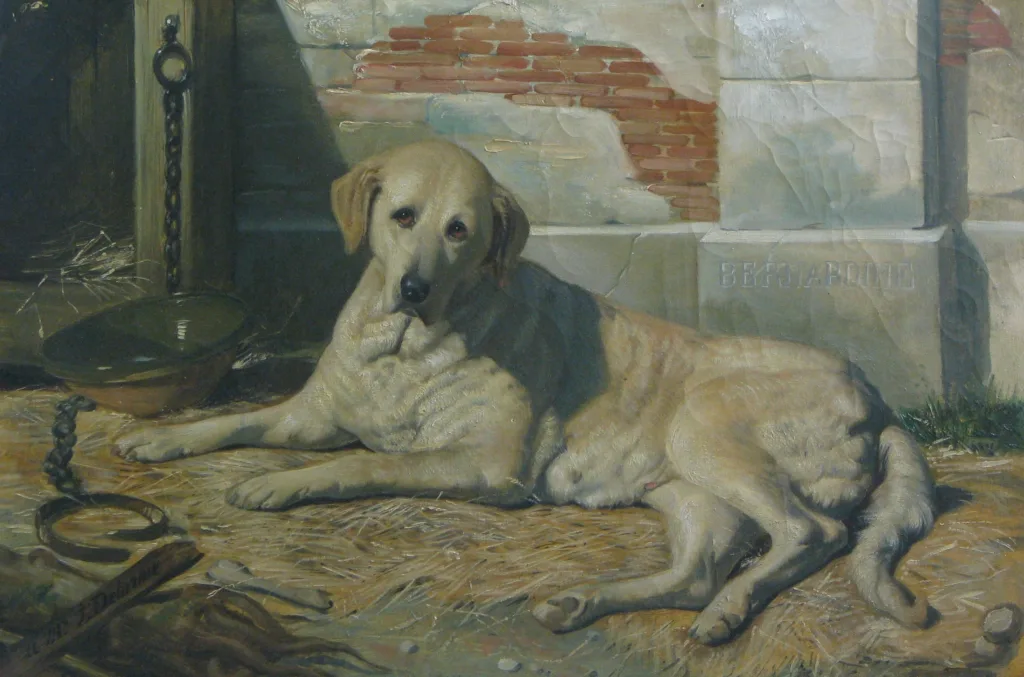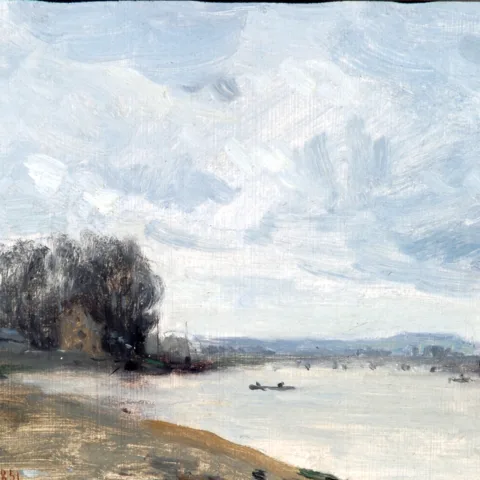The Bowes Museum Blog

Give A Dog A Loan

In the conservation studio I am currently treating a painting [B.M.911] ready for it to go on loan in January to a major venue in London. The painting is of Josephine Bowes’s much beloved dog, Bernadine, painted by the French artist Antoine Dury, circa 1850. Before a painting can go on loan, initial assessments and estimates are made of any conservation work that may be required based on its condition. This assessment is usually carried out when the painting is still framed and on display or in store.

Bernadine, unframed in the studio, before treatment
This lovely Labrador had mostly been on display unglazed in Josephine’s bedroom (a period room setting within the Museum) since 2001 and the initial assessment suggested only remedial treatment such as a surface clean to show off Bernadine’s glossy coat. In addition, refitting the painting in the frame more securely and fitting a backboard to protect the painting from impact during transportation was recommended.
Once off display and in the studio it was time to unframe the painting and carry out a more thorough technical examination using different light sources and document the process with photography and written reports.

Detail of ground and paint layers adhered to foam and frame rebate

Detail of damage caused by adhesive: loss of paint and ground layers and torn canvas threads
However, the process of unframing the painting became a real sticking point, literally! When I lifted the painting out of its frame, I found that two sections of paint layers had detached from the canvas and were firmly adhered to the inside of the frame, leaving large losses revealing torn canvas on the bottom edge of the painting.
This was caused by foam that was glued to the inside of the frame in an effort to protect the painting from rubbing against the frame, a measure probably carried out in the 1960’s. Though clearly carried out with the best of intentions, this is a good example of why conservation-grade reversible materials are used in modern conservation treatments. The foam used was possibly polyurethane that had degraded and likely caused the partial removal of varnish where it had been in direct contact with the painting. The glue used was likely to be a strong contact adhesive that seeped through the open-cell structure of the sponge to the paint layer.

Detail of corner of the painting when still framed showing yellow foam used to cushion the painting in the rebate
Today modern framing conservation methods utilise an inert closed cell foam such as Plastazote® to cushion the painting in the rebate, which can be adhered to the frame with a reversible, water-soluble glue such as High Tack Fish Glue, in order to prevent something like this sticky situation from occurring.
Luckily the paint loss is not in a significant part of the image and positioned at the bottom edge, it is covered beneath the frame rebate.
The first treatment was to attempt to salvage the fragments from the frame without damaging them with the intention that they might be reattached to the canvas. The degraded and cross-linked adhesive was found to be resistant to all solvents tested so could not be softened and removed. It was then decided to mechanically remove the section, by carefully slicing with a scalpel, beneath the hardened glue layer and into the frame, in order to retain as much of the original paint loss as possible.

One section of fragment after removal from the frame, temporarily adhered to Melinex with BEVA 371 film
To do this, a piece of thick Melinex® was adhered with BEVA® 371 film (a heat-activated adhesive) to the detached paint layers, providing a stiff substrate that would prevent the layers from contracting and crumbling during removal.
What began as a relatively small job in preparing a painting for loan has developed into an interesting technical conservation challenge. I’ll keep you posted on the next stage of treatment and any new challenges I have encountered.
I am now into my fifth week of the Painting Conservation Internship at The Bowes Museum where I’m quickly finding your role as a conservator can be multifaceted, requiring you to work outside of your specialism.

Carrying out conservation work in-situ in the Ceramics Gallery during the re-display
Last week for instance, I put my filling and retouching skills to the test (normally reserved for easel paintings) on a large urn with a chipped edge in preparation for the re-display of the ceramics gallery, which opened last Friday.

Detail of ceramic with the damage area filled before retouching

Detail of area after re-touching on top of fill with acrylic
And this week I was condition checking photographs prior to their display in the exhibition ‘Robert Mapplethorpe: The Magic in the Muse’.

Condition checking Patti during the installation of the Robert Mapplethorpe photography exhibition
Pauline Murray, ICON/HLF Paintings Conservation Intern
![]()







